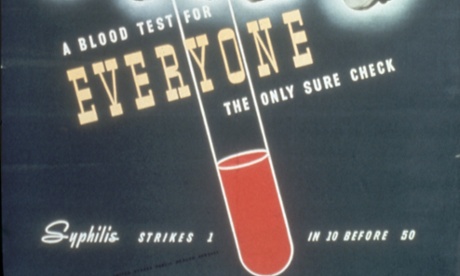Unprotected sex between men the main cause of new infections in the four years to 2013, experts say

Syphilis has reached its highest level recorded in Australia, with the increase almost exclusively among gay men.
Health experts are calling for an increased focus on the potentially deadly bacterial disease after data showed 1,765 people were diagnosed with it in Australia last year – a 34% increase on the number documented in 2009.
The annual surveillance report on the country’s sexual health produced by the Kirby Institute at the University of New South Wales said unprotected sex between men was the main driver of new diagnoses between 2009 and 2013.
Associate Professor David Wilson, one of the authors of the report that looked at viral hepatitis and sexually transmissible infections, said syphilis remained far less common in Australia than many other sexually transmitted diseases.
But there had been a rise in men becoming infected and this was because of the increase in condomless sex between men, he said. Syphilis was increasing almost exclusively among gay men and men who have sex with men, he said.
“What we have seen is there have been decreases in condom use in that population – that’s likely to be one of the key reasons for that,” he said.
Professor John de Wit, director of UNSW’s Centre for Social Research in Health, said people tended to think of syphilis as an old and rare disease, which was not helpful.
If syphilis is not diagnosed it can have a significant impact on people’s health. Symptoms of late-stage syphilis include difficulty coordinating muscle movements, paralysis, numbness, blindness and dementia. The disease damages the internal organs and can result in death.
Other statistics include the finding that the number of people dying from liver disease related to hepatitis C, which is transmitted through blood-to-blood contact, has more than doubled in a decade.
More than 10,000 people are diagnosed with the virus each year. About 630 Australians died from hepatitis C-related liver failure and liver cancer in 2013.
De Wit said Hepatitis C was a serious health issue that was much in need of more public and policy attention.
The report, released on Thursday as part of the ninth Australasian Viral Hepatitis Conference in Alice Springs, also shows gonorrhoea rates have increased. In 2013 there were 14,947 new diagnoses of the STI, up 81% in the past five years.
But, in good news, the surveillance report says chlamydia rates have slightly declined for the first time in recent history, although it remains the most common STI. Last year there were 82,537 new cases of the infection, which can cause permanent damage to a woman’s reproductive system.
Cases of genital warts among women have also dropped dramatically owing to the introduction of the Human Papillomavirus vaccination program in 2007, according to the report.
